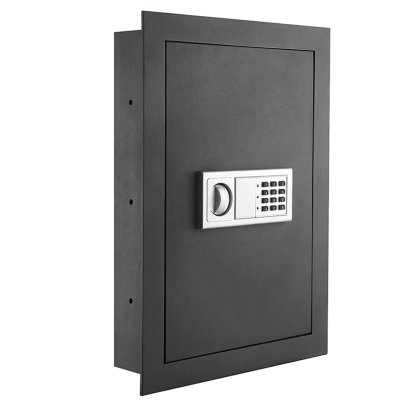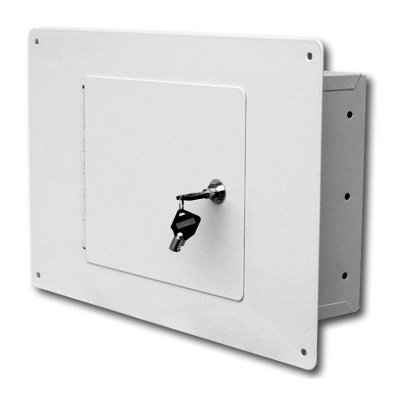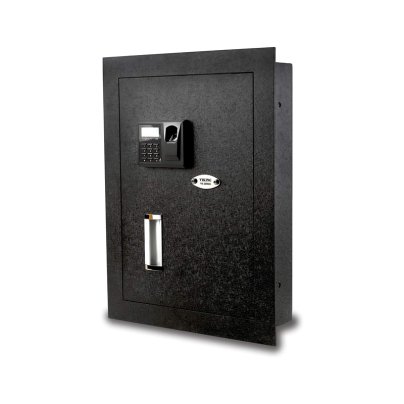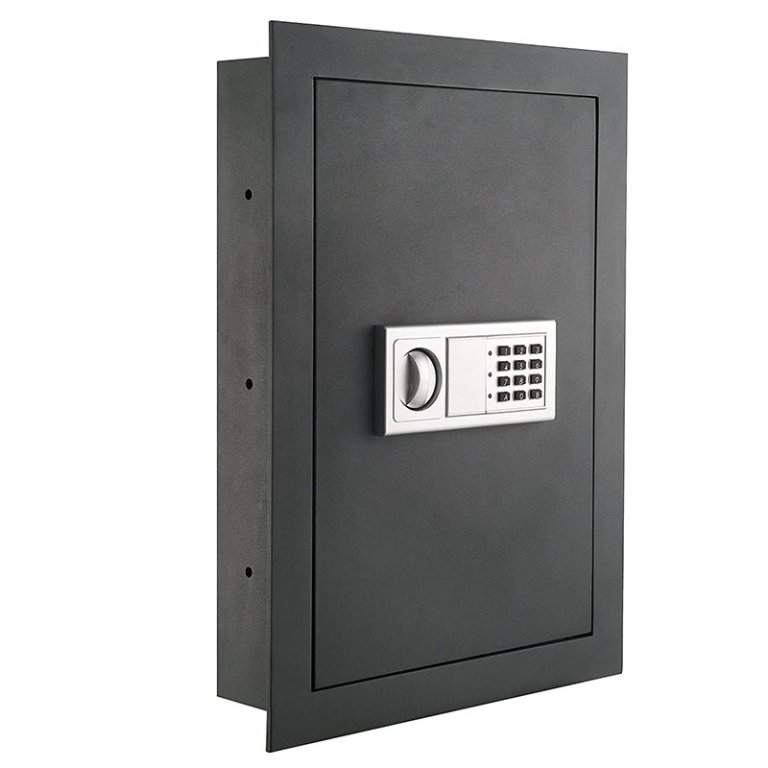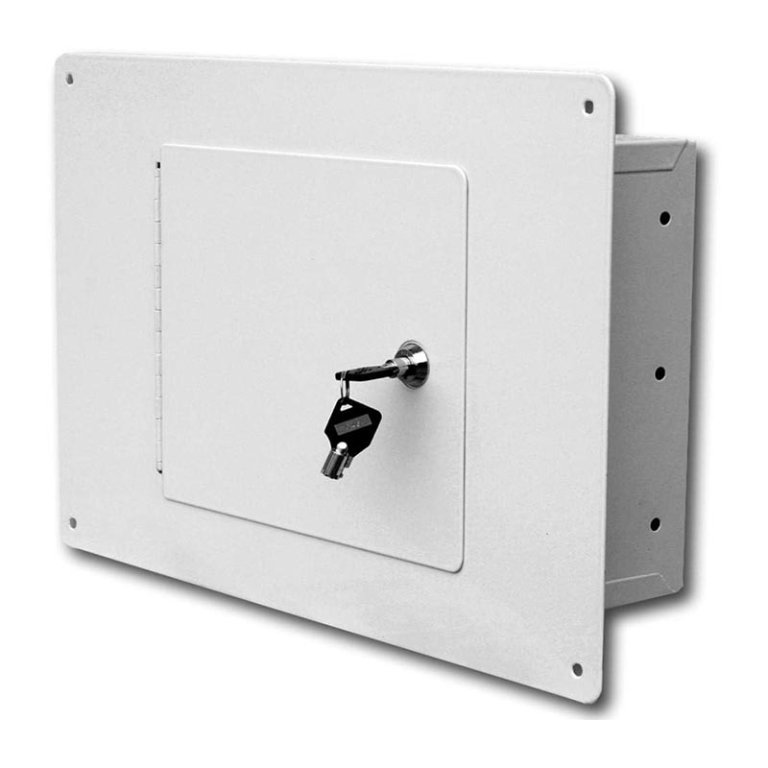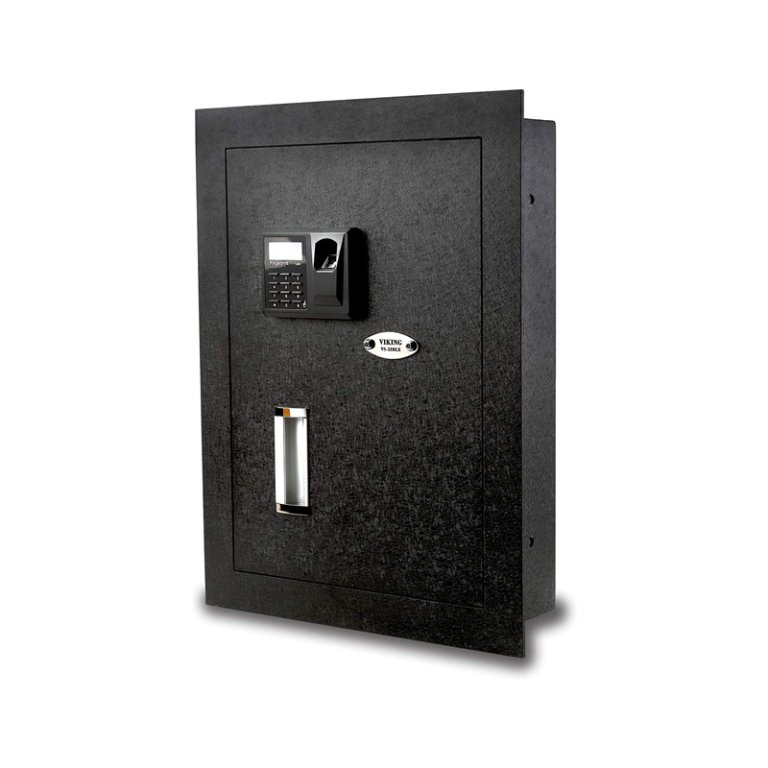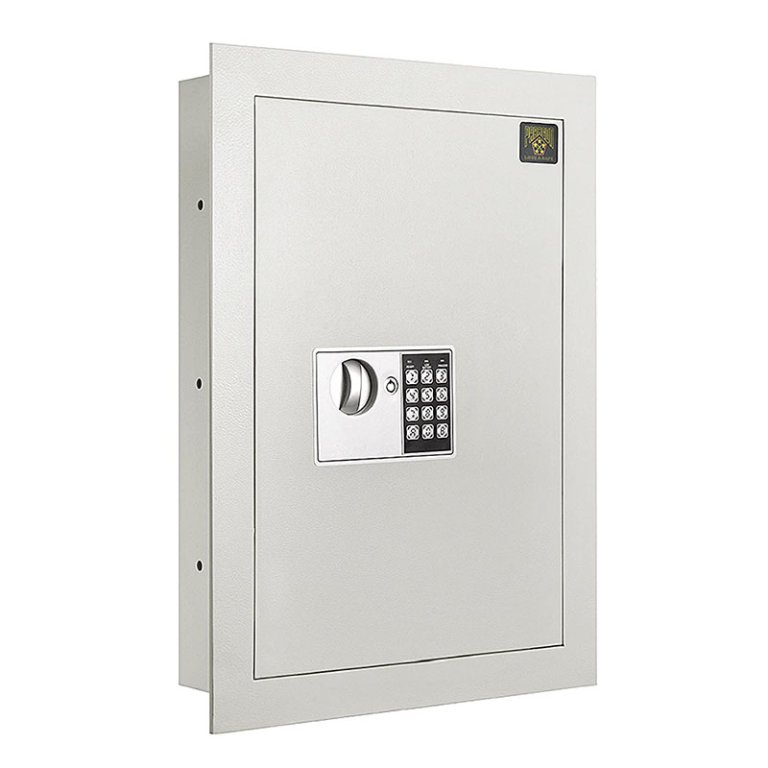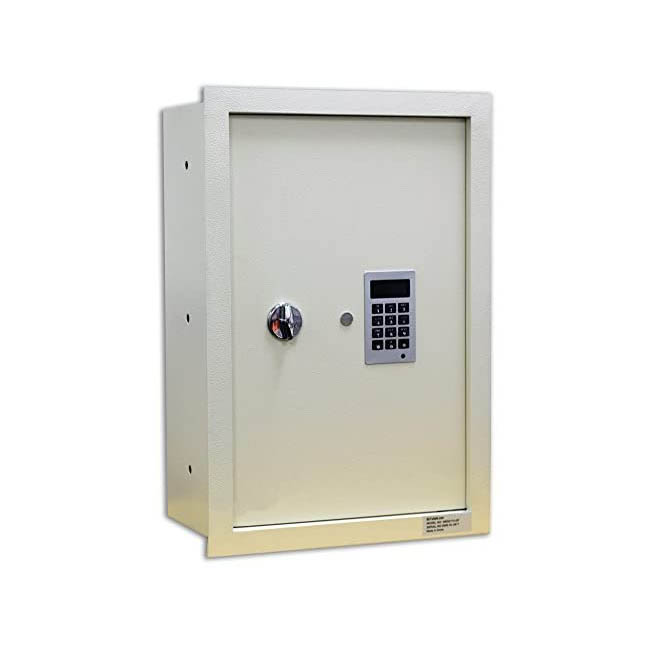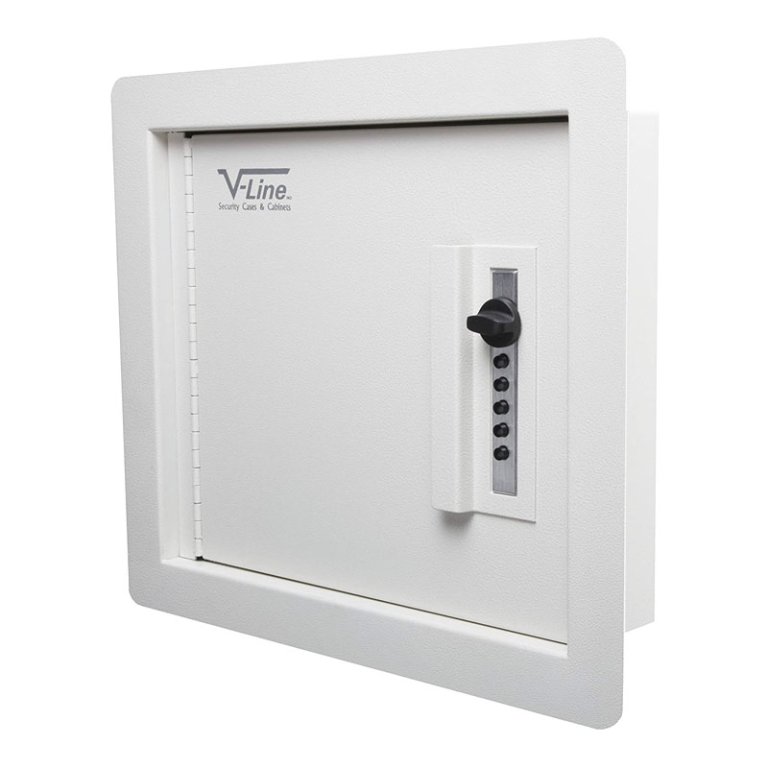
We may earn revenue from the products available on this page and participate in affiliate programs. Learn More ›
If you keep precious jewelry, documents, and/or heirlooms at home, you may want to conceal these items in a wall safe. These clever devices are designed to fit recessed between wall studs, offering ample space to stow small valuables. Wall safes are installed by cutting a hole in the drywall with a drywall saw, sliding the safe into the space, and then bolting the sides of the safe (from the inside) to the adjacent wall studs. Then, once the goods are locked up, the safe itself can be concealed from view with a mirror or painting, making it far more secure than a desk drawer or jewel box atop a dresser.
Wall safes are designed to fit within the standard 14.5-inch space between wall studs with the front of the safe flush with the surface of the wall. If you’re looking to secure prized possessions at home, check out these picks for some of the best wall safes.
- BEST OVERALL: Paragon Lock & Safe 7725 Superior Wall Safe
- BEST BANG FOR THE BUCK: Homak Small Wall Safe
- BEST BIOMETRIC: Viking Security Safe VS-52BLX Hidden Wall Safe
- BEST DIGITAL: Paragon Lock & Safe 7700 Flat Electronic Wall Safe
- BEST FIREPROOF: BuyaSafe WES2113-DF Fire-Resistant Electronic Safe
- BEST FOR JEWELRY: V-Line Quick Vault In-Wall Pistol Safe
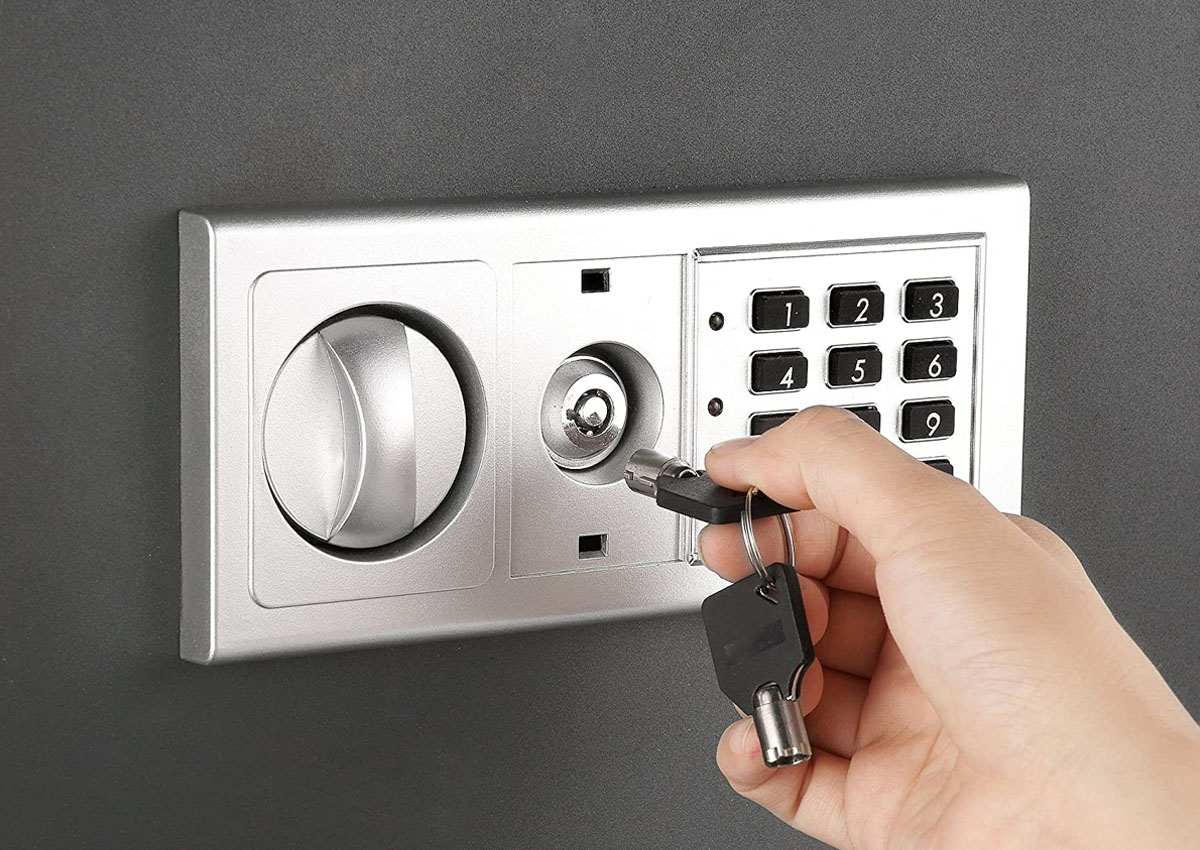
How We Chose the Best Wall Safes
Our top picks include various types of safes offering different security features, materials, and locking/unlocking options to accommodate different preferences and items that require protection. Many of the above models come with varying depths and heights to fit documents, firearms, jewelry, and other important objects, with useful design elements like interior shelving and scratch-proof metal.
Each wall safe includes reliable security features such as customizable, numerical keypad entry, backup keys, 1-2 locking bolts, and steel construction. Another takeaway from these home safes is the thin flanges included for concealment behind mirrors or paintings. Many of the top picks also come with pre-drilled holes and bolts for installation, as well as batteries for digital keypads.
Our Top Picks
To qualify as a Top Pick, a wall safe should be strong and secure enough to deter thieves yet simple to open by its rightful owner. The following wall safes install within the stud space between two wall studs. While the width measurements below exceed the available space between studs on 16-inch centers, those measurements indicate the safe’s face frame—the box portion of each—is no wider than 14.5 inches and will slide between the studs.
Best Overall
Paragon Lock & Safe 7725 Superior Wall Safe
Pros
- Strong alloy-steel build lasts for long-term use and resists tampering
- Includes an LED digital keypad, keypad lock, and alarm system
- Secure 0.8-inch steel walls and tamper-resistant hinges
- Comes with built-in scratchproof shelves. 4 AA batteries, and bolts for installation
Cons
- Not a fireproof wall safe; may not be ideal for some users’ needs
Product Specs
- Lock type: Digital keypad or keyed
- Material: Alloy steel
- Capacity: 0.83 cubic feet
- Special features: Tamper-resistant hinges, scratchproof shelves
The Paragon Lock & Safe 7725 is a solid choice for storing jewelry or other valuables. It features robust 0.8-inch steel walls and tamperproof hinges. The inside shelves have soft gray matting that won’t scratch jewelry or other delicate items.
The Paragon safe comes with both an LED digital keypad and a keyed lock in case users forget the code. It can also be programmed to emit a buzzing alarm if someone tries to access the safe without permission. The safe measures 22 inches high by 16.25 inches wide by 4 inches deep. Bolts are included for attaching the sides of the safe to the adjacent wall studs. Plus, the 4 AA batteries required for the digital keypad are included and last for 4 to 5 months.
Get the Paragon Lock & Safe 7725 wall safe at Amazon.
Best Bang for the Buck
Homak Small Wall Safe
Pros
- Compact size fits easily behind small mirrors and paintings; can also be installed as a floor safe
- Piano-hinge door design closes flush to the frame to prevent prying and tampering
- Foam interior keeps all items in the safe intact and protected
Cons
- Smaller than comparable options on the market; may not hold any large items
- No interior capacity listed on brand website
Product Specs
- Lock type: Tubular/keyed
- Material: Alloy steel and a powder coat epoxy finish
- Capacity: Unlisted
- Special features: Foam interior lining
If shoppers don’t want to spend a fortune to secure their valuables, they’ll want to consider the Homak small wall safe. This affordable safe lets users lock up precious items behind a painting or even in a closet’s back wall. If desired, this model can also be used as a floor safe. The piano hinge closes flush to the frame when closed to prevent any prying or unwanted tampering while the foam interior lining keeps jewelry, guns, or documents safe and intact.
The Homak safe is made from heavy-duty 1.5 millimeter alloy steel with a powder coat epoxy finish. It bolts securely to adjacent studs in a 2×4 stud wall and relies on a high-security tubular locking system that requires a special key to open. Note that tubular locks are more difficult to pick than straight key locks. The safe is 11.75 inches high by 17.12 inches wide by 4 inches deep.
Get the Homak wall safe at Amazon.
Best Biometric
Viking Security Safe VS-52BLX Hidden Wall Safe
Pros
- Alloy steel, scratch-resistant military coating, and pry-resistant surface flange construction
- Biometric lock or backup keypad combination for easy user access and versatility
- Stores up to 32 fingerprints; suitable for use in offices or in homes with multiple users
- Comes with 2 motorized locks, adjustable shelves, and interior LED light
Cons
- More expensive than standard wall safes on the market
- Wider than some units; not compatible with some wall depths
- Not fireproof; may not be ideal for some users’ preferences
Product Specs
- Lock type: Biometric or keyed
- Material: Steel and scratch-resistant military coating
- Capacity: 970 cubic inches
- Special features: Built-in interior LED light
No need to remember a combination or where a key was stashed with the Viking Security biometric wall safe. This fingerprint lock’s optical sensor can scan and store up to 32 different fingerprints, so anyone with permission can open it. Once users scan a fingerprint, they simply position the same finger on the optical sensor, and the lock will open. Buyers can also program in a backup numerical combination, if desired.
The steel body of the safe has scratch-resistant military coating and bolts to adjacent wall studs, and the laser-cut surface flange fits tightly against the drywall to keep anyone from prying the safe away. Two motorized locking bolts secure the door when closed, and the inside features three adjustable shelves and a built-in LED light for easy viewing. The outside of the safe measures 19 inches high by 14 inches wide by 4 inches deep.
Get the Viking Security wall safe at Amazon or Walmart.
Best Digital
Paragon Lock & Safe 7700 Flat Electronic Wall Safe
Pros
- Durable alloy-steel construction resists wear and unwanted tampering
- Comes with programmable keypad with 3 to 8 digit combination options
- 2 adjustable shelves allow users to customize the interior based on what they need to store
- Includes backup key in case of emergency or forgotten combination
Cons
- Slightly less internal depth than similar units on the market
Product Specs
- Lock type: Electronic keypad or keyed
- Material: Alloy steel
- Capacity: 0.83 cubic feet
- Special features: 2 adjustable shelves
In an era of multiple passwords and codes, this Paragon Lock & Safe model offers a safety net in case users can’t remember the combination. It features a programmable electronic keypad in which buyers can store a combination between three and eight digits long, but in the event they forget the code, they can open the safe with the included master key.
Made from solid alloy steel, the safe recesses between standard wall studs, bolts securely to the studs, and lies flush against the wall surface to be covered by a piece of art or a mirror. Two heavy steel bolts lock the door in place. Plus, the safe features two adjustable shelves for stashing a variety of documents and valuables. The safe measures 22 inches high by 16.25 inches wide by 4 inches deep.
Get the Paragon Lock & Safe 7700 wall safe at Amazon.
Best Fireproof
BuyaSafe WES2113-DF Fire-Resistant Electronic Safe
Pros
- Fire-resistant, heavy-duty gauge-steel construction provides extreme durability
- Can withstand exposure to fire and protect personal items for over 2 hours
- Made with 2 heavy-duty locking bolts and 2 removable shelves
- Comes with a programmable keypad entry, a backup key, and predrilled holes for mounting
Cons
- Heavier than the average wall safe at 56 pounds
- Slightly more expensive compared to similar models
Product Specs
- Lock type: Digital electronic lock or keyed
- Material: Heavy-duty gauge steel
- Capacity: 0.75 cubic feet
- Special features: Predrilled holes and an exterior flange
Users needn’t worry about their valuables being damaged by fire with the BuyaSafe, which is designed to be installed in 2×8 framing members in custom-built oversize walls. The BuyaSafe comes with a 2-hour fire rating, meaning it will protect the contents for at least 2 hours in a fire. While users program a secret numerical code into the electronic keypad, the safe comes with a mechanical override key in case they forget.
The
is made from heavy-duty gauge steel, features two heavy-duty locking bolts and two adjustable shelves, and measures 20.75 inches high by 13.625 inches wide by 8 inches deep. The BuyaSafe comes with predrilled holes for bolting to wall studs and features a thin flange along the front perimeter so that the safe fits flush against the drywall for a finished look.
Get the BuyaSafe wall safe at Amazon.
Best for Jewelry
V-Line Quick Vault In-Wall Pistol Safe
Pros
- Durable steel construction prevents unwanted tampering and lasts for long-term use
- Stores up to 1,081 combinations with a button lock; suitable for offices or homes with multiple users
- Pry-resistant door and soft padded shelving provide added user-friendliness
Cons
- Lock is not digital; may be a learning curve for some users
- Locksmith is required if access code is lost (no backup keys included)
Product Specs
- Lock type: Mechanical button lock
- Material: Steel
- Capacity: 0.35 cubic feet
- Special features: Stores up to 1,081 combinations
Precious gems and metals can be prone to scratching, so this V-Line model, with its two interior felt-lined shelves, may be the best bet to protect delicate items. The V-Line safe is designed to install between standard wall studs and be disguised with a mirror or painting in front.
It features a mechanical button lock that can be programmed with any one of 1,081 combinations. This isn’t a digital lock, so users needn’t worry about batteries, and there are no keys that could fall into the wrong hands. As a result, it might be wise to hide a written copy of the combination, because if users forget it, they’ll need a locksmith to open the safe.
This V-Line safe measures 15 inches high by 17 inches wide by 3.5 inches deep and features steel construction, a pry-resistant door, and lock bolts that extend through the frame of the case for added security.
Get the V-Line wall safe at Amazon.
Jump to Our Top Picks
What to Consider When Choosing a Wall Safe
For many who invest in a wall safe, the desire to keep the safe out of sight is nearly as important as keeping the interior contents secure. A wall safe, which sits between framing studs, is relatively shallow (less than 5 inches deep) and can be disguised by hanging a piece of art over it.
Accessibility and Locking Mechanism
Wall safes come with four main types of locks, each with pros and cons. Consider which of the following types best suits your home and security needs.
- Biometric: This type of locking mechanism requires only a fingerprint or retinal scan to open the safe, making it the quickest and easiest to open. Depending on the model, multiple fingerprints or retinal scans can be stored in the memory to allow a range of users access.
- Combination dial: This is the same type of lock still found on many school gym lockers, and it has a tried-and-true history of keeping valuables safe. The user spins the dial once or twice and then turns it back and forth to a preset combination to open the lock.
- Numerical keypad: Common on many of today’s safes, a numerical keypad requires the user to enter a four- to eight-digit code in sequence. The keypad is usually powered by a battery that can be replaced without opening the safe.
- Keyed lock: Sometimes the only lock on a wall safe is a keyed lock, although often a key is a backup for another type of lock, such as a combination lock or a numerical keypad. If users forget a combination, having a key to open the lock will save them a locksmith’s fee.
Material and Quality
Heavy-gauge steel and steel alloys are the materials of choice for most of today’s wall safes. The exterior steel may be powder coated to reduce the risk of rust and corrosion. Safe interiors vary and may contain foam with cutouts designed to hold various handguns or fabric shelf lining to protect the jewelry from becoming scratched.
The quality of a wall safe depends on its construction and the strength of its locking mechanism. Wall safes are not quite as secure, on average, as freestanding safes because wall safes have less room to include thicker, fire-safe walls. Still, within this category, a range of quality is found, from lightweight steel safes that can be pried open with a crowbar to heavier-gauge safes with multiple locking bars and pry-resistant doors.
Size and Capacity
Wall safes are typically fairly small because residential construction standards limit the width and depth of the space in which they sit. Standard residential stud spacing is 16 inches from the center of one stud to the center of the next, which leaves only 14.5 inches of space between the studs. The stud space’s depth will be either 4 inches in a 2×4 wall or 6 inches in a 2×6 wall, making wall safes relatively shallow; the depth measurement factors in the thickness of 0.5-inch drywall, which is standard on residential walls.
Allowing for the room taken up by the safe’s steel walls, the interior depth may be as little as 3 inches. All that said, tall and narrow wall safes for long gun storage are available, and a few deeper safes install in 2X8 walls, but since this is not standard framing, you may have to hire a contractor to build a wall this deep.
Additional Features
You can find wall safes with digital memories that record every attempt to access the safe as well as safes that will emit an alarm if an unauthorized person attempts to open them. Others may include interior lighting allowing the user to retrieve valuables in the dark, or a silent mode to enable them to open the safe without the telltale beeps a digital pad usually makes.
Tips for Buying and Using a Wall Safe
Wall safes attach to the inside of a house’s stud walls, so make sure you purchase a safe that’s sized correctly for your wall framing. Safes designed to fit in 2×6 stud walls will not work in 2×4 stud walls.
- Use a stud finder (an electronic tool that senses stud location beneath drywall) to learn the location of the studs, so you can accurately cut the drywall between them. If you don’t have a stud finder, look for small nail holes in the baseboard trim, as those nails are hammered into wall studs.
- You’ll want to avoid damaging any wires that may lay behind the drywall where you want to place your safe, so carefully cut a small hole between the studs first to check for wires. Typically, if wires are in a stud space, they will be attached to the inside of one of the studs. Additionally, wires are often run horizontally through stud spaces about 1.5 feet up from floor level, so you might want to choose a spot a bit higher for your safe.
- Wall safes feature holes inside that allow you to bolt the safe to the studs on either side.
The Advantages of Owning a Wall Safe
Being able to secure valuables and documents offers peace of mind and security, but wall safes provide an extra element of secrecy since they can be installed at the back of a closet or behind a piece of hanging art.
- Locking firearms in a wall safe may comply with some state and community ordinances.
- A quick-access wall safe prevents unauthorized access but allows you to retrieve contents quickly.
- A wall safe offers out-of-sight protection for your valuables.
FAQs
If this is the first time you’ve shopped for a wall safe, you may still have some questions. Consider the answers below.
Q. Are wall safes impact-resistant?
To an extent, and some more than others. A good wall safe should withstand the force of someone beating on its door with a hammer for a while. But if a determined thief with enough physical strength continues beating with force, the door will likely give way at some point. Wall safes, in general, are slightly less secure than freestanding safes because they must fit in limited stud spaces, necessitating thinner steel walls.
Q. Are wall safes secure?
Wall safes offer a good measure of security, but they’re not impenetrable if someone is determined to break into one. Choosing a good hidden location increases the level of security.
